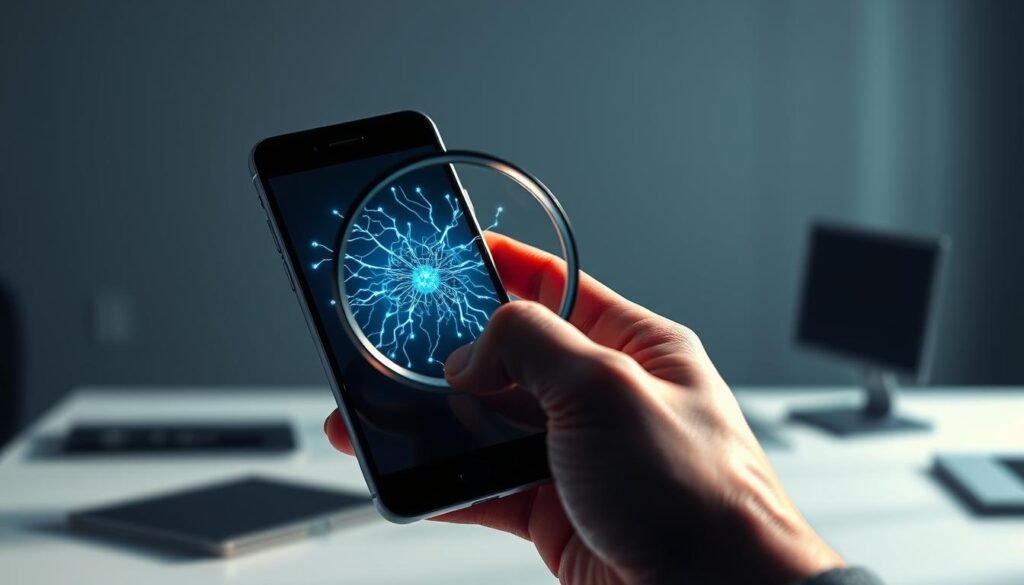Have you ever wondered how much more you could accomplish if you weren’t constantly interrupted? In today’s fast-paced world, staying focused at work feels like an uphill battle. The average worker checks their device 150 times a day, losing valuable time and energy.
These interruptions don’t just break your flow—they add up. Research shows that 720 work hours are lost annually due to unnecessary distractions. The good news? You don’t have to accept this as the norm.
We’ve tested a simple, four-step solution that takes less than an hour to implement. By managing your device usage, you can reclaim your focus and achieve more. Let’s explore how small changes can lead to big results in your professional life.
Key Takeaways
- Constant interruptions can cost you up to 720 work hours each year.
- Checking your device 150 times daily breaks your focus and reduces productivity.
- A four-step solution can help you regain control in under an hour.
- Managing notifications is key to staying focused at work.
- Small changes can lead to significant improvements in your professional success.
Why Phone Distractions Are Hurting Your Productivity
The constant pull of notifications is quietly sabotaging your focus. Research shows that after an interruption, it takes an average of 23 minutes to regain full concentration. This fragmented attention adds up, leaving you with less time to complete meaningful tasks.
Neuroscience explains this phenomenon as “attention fragmentation.” When your brain switches between tasks, it leaves behind “attention residue,” making it harder to dive deep into your work. This is why the average focus span has dropped to just 3 minutes in today’s fast-paced environment.
Many people experience “phantom vibration syndrome,” where they feel their device buzz even when it hasn’t. This constant anticipation keeps your mind on edge, reducing your ability to focus. At work, this can lead to missed deadlines and lower-quality output.
The “email arms race” is another productivity killer. People feel pressured to respond immediately, creating a cycle of constant checking. This not only wastes time but also increases stress levels throughout the day.
These interruptions aren’t just a personal issue—they have a financial impact. Studies estimate that productivity losses cost companies thousands of dollars per employee each year. Over time, this can lead to career stagnation and missed opportunities.
Even outside of work, distractions take a toll. For example, family dinners are often interrupted by devices, harming relationships. Additionally, blue light from screens can disrupt sleep quality, further reducing your ability to focus the next day.
By understanding these challenges, we can take steps to reclaim our attention and improve productivity. Small changes, like managing notifications, can make a big difference in how we spend our time and energy.
Understanding the Psychology Behind Phone Addiction
The science behind smartphone addiction reveals surprising truths about our behavior. Many of us feel an irresistible pull toward our devices, even when we know it’s not productive. This isn’t just a bad habit—it’s deeply rooted in our brain chemistry and psychology.
The Role of Dopamine in Smartphone Use
Dopamine, often called the “feel-good” chemical, plays a key role in addiction. Every time we receive a notification or check our device, our brain releases dopamine. This creates a sense of reward, encouraging us to repeat the behavior.
Research shows that app designs mimic slot machine mechanics. Variable rewards, like unpredictable notifications, keep us hooked. This is similar to how casinos use operant conditioning to keep players engaged.
Over time, excessive smartphone use can reduce dopamine receptors. This makes it harder to feel satisfaction from everyday activities, driving us to seek more screen time.
How Notifications Hijack Your Attention
Notifications are designed to grab your attention. The sound of a notification triggers anticipation, followed by a small reward when you check it. This cycle keeps you coming back for more.
An MIT study found that people respond to notifications within seconds, even during important tasks. The use of red alerts in app icons exploits color psychology, signaling urgency and importance.
This constant state of hyper-alertness can lead to anxiety and reduced focus. By understanding these tactics, we can take steps to regain control over our attention.
Step 1: Remove Unnecessary Apps
Decluttering your device is the first step toward reclaiming your focus. On average, we have 40 unused apps taking up space and mental energy. By removing these, you can free up storage and reduce the temptation to scroll aimlessly.
How to Identify Zombie Apps
Start by identifying apps you haven’t used in the last three months. These “zombie apps” often linger on your home screen, cluttering your digital space. A simple rule: if it hasn’t served a purpose in 90 days, it’s time to let it go.
To make this process easier, try the “app obituary” exercise. Write a short note about why you’re deleting each app. This helps you evaluate whether it’s emotionally or functionally valuable.
Using iOS and Android Tools to Offload Apps
Both iOS and Android offer built-in tools to streamline app removal. On iOS, use the Offload App feature to delete apps while keeping their data. This is perfect for apps you might need later.
Android users can explore Digital Wellbeing tools to track app usage. These insights help you decide which apps are worth keeping. For preinstalled bloatware, consider disabling or hiding them to reduce clutter.
Organize residual apps into folders to keep your home screen clean. This simple strategy can save you time and make your device more functional.
Finally, schedule quarterly app audits to maintain a clutter-free device. This habit ensures you’re only keeping what truly adds value to your life.
Step 2: Replace Distracting Apps with Productive Alternatives
Small changes in your app usage can lead to big improvements in productivity. Instead of letting your device control your day, take charge by swapping out time-wasting apps for tools that support your goals. This step focuses on creating a healthier digital environment that aligns with your priorities.
Scheduling Social Media Time
Social media can easily consume hours of your day if left unchecked. To regain control, try setting a specific time for checking these platforms. For example, dedicate a single hour in the evening to catch up on updates. This approach, known as “context-specific device use,” helps you stay focused during work hours.
Using tools like Chrome site blocker extensions can further limit access during designated times. These tools block distracting sites, ensuring you stick to your schedule. Additionally, consider accessing social media through a browser instead of an app. This small change can reduce the urge to scroll endlessly.
Replacing Games with Educational Content
Games are a common source of distraction, but they can be replaced with more enriching alternatives. Apps like Duolingo for language learning or Blinkist for micro-learning offer engaging ways to spend your time. These tools provide a sense of accomplishment without the guilt of wasted hours.
For example, instead of playing a mobile game during breaks, try a quick lesson on Duolingo. Over time, these small habits can lead to significant personal growth. If you enjoy gaming, consider switching to a console for a more intentional experience. This distinction helps separate leisure from work-related device use.
Another practical tip is to use a smartwatch for checking the time instead of reaching for your device. This simple switch minimizes unnecessary interactions with your apps, keeping you on track throughout the day.
Step 3: Rearrange Your Home Screen for Focus
Your home screen is the gateway to your daily habits and focus. A cluttered layout can lead to unnecessary scrolling and wasted time. By organizing it intentionally, you can create a more productive digital environment.
Creating an “Essential Home Screen”
Start by categorizing your apps into three groups: primary tools, aspirations, and slot machines. Primary tools are apps you use daily, like email or calendars. Aspirations are apps that support your goals, such as fitness trackers. Slot machines are apps designed to keep you hooked, like social media.
Use Tony Stubblebine’s method to create folders for these categories. On iOS, press and hold an icon to start organizing. Android users can customize their app drawer for easier access. Aim for an ideal home screen with 5-6 icons to reduce visual clutter.
Using App Search Instead of Scrolling
Scrolling through multiple screens wastes time and breaks your focus. Instead, activate app search on your device. On iOS, swipe down on the home screen to access the search bar. Android users can use the app drawer’s search feature.
This approach helps develop muscle memory for finding apps quickly. To further reduce distractions, try grayscale mode. This dulls the visual appeal of apps, making them less tempting to open.
Adopt the “app desert” philosophy by keeping only essential apps on your home screen. This minimizes unnecessary interactions and keeps you focused on what truly matters.
Step 4: Reclaim Control Over Notifications
Taking charge of your notifications can transform your daily workflow. With only 15% of users customizing their alerts, most people are missing out on a simple way to boost focus. By managing your settings, you can reduce interruptions and stay on track.
How to Adjust Notification Settings on iOS and Android
On iOS, start by opening the Notification Center. Here, you can customize alerts for each app. Use the “Sound/Sight/Sayonara” system: mute unnecessary sounds, hide previews, and disable alerts for apps you rarely use. For example, Yelp notifications can be limited to only urgent updates.
Android users can manage alerts through per-app settings. Go to the app’s info page and adjust permissions. Consider disabling notifications for apps that don’t add value. Both platforms offer emergency bypass features, ensuring critical alerts still come through.
Using “Do Not Disturb” Features Effectively
The Do Not Disturb mode is a powerful tool for focus. On iOS, schedule it during work hours or meetings. Android’s Driving Mode can also be repurposed for focused sessions. Just ensure it’s not misused, like during family time.
Introduce “notification fasting” periods where you silence all alerts for 30 minutes. This helps reset your focus. Regularly audit your notification permissions to avoid defaults that clutter your screen. Over time, these small changes can lead to significant productivity gains.
Building Long-Term Habits to Stay Focused
Creating lasting habits is the key to maintaining focus and productivity in our lives. Small, consistent changes can lead to significant improvements over time. By integrating mindful practices and setting boundaries, we can create a healthier balance between work and personal time.
Keeping Your Device Out of the Bedroom
One of the most effective habits is establishing a device-free bedroom. Blue light from screens can disrupt sleep, making it harder to focus the next day. Instead, set up a charging station in another room to avoid temptation.
Replace your device with a traditional alarm clock to eliminate the need for it in your sleep space. This simple change can improve sleep quality and strengthen your relationships by reducing late-night scrolling.
Practicing Mindfulness and Meditation
Mindfulness and meditation are powerful tools for staying focused. Apps like Headspace and Smiling Mind offer guided sessions to help you develop these practices. Start with just five minutes a day to build consistency.
Try the 4-7-8 breathing technique: inhale for four seconds, hold for seven, and exhale for eight. This method calms the mind and prepares you for deep focus. Pair it with a pre-sleep ritual to enhance its benefits.
Introduce a notification-free Sunday to reset your focus and recharge. Use this time to connect with loved ones or enjoy offline activities. Quarterly digital detox weekends can also help maintain this balance.
Be vigilant about “habit creep,” where old patterns resurface. Regularly assess your routines to ensure they align with your goals. By stacking small habits, like morning meditation and evening journaling, you can create a sustainable system for focus and productivity.
Conclusion: Take Back Your Time and Focus
Regaining control over your daily habits can lead to profound changes in how you manage your time and focus. By following the four-step implementation journey, you can reclaim up to 720 hours annually, significantly boosting your productivity.
Understanding neuroplasticity principles helps reinforce that small, consistent changes can rewire your brain for better habits. Gradual habit formation ensures these changes stick, leading to long-term benefits in both your personal and professional life.
Remember, your phone and apps should serve you, not control you. By adopting the “tech servant vs master” philosophy, you can create a healthier relationship with technology. Start today, and take the first step toward a more focused and fulfilling life.
FAQ
How do smartphone notifications affect my focus?
Notifications trigger dopamine release, making it hard to resist checking your device. This constant interruption breaks your concentration and reduces productivity.
What are zombie apps, and why should I remove them?
Zombie apps are rarely used but take up space and attention. Removing them declutters your device and minimizes distractions, helping you stay focused.
How can I replace distracting apps with productive ones?
Swap games or social media for apps that offer educational content or skill-building. Schedule specific times for entertainment to balance productivity and leisure.
What’s the benefit of rearranging my home screen?
A well-organized home screen reduces unnecessary scrolling and keeps essential tools accessible. This setup helps you stay on task and avoid distractions.
How can I manage notifications effectively?
Adjust settings to mute non-essential alerts and use “Do Not Disturb” during focused work sessions. This minimizes interruptions and boosts concentration.
What habits can help me stay focused long-term?
Keep your device out of the bedroom, practice mindfulness, and set boundaries for usage. These habits foster better focus and reduce dependency on technology.








